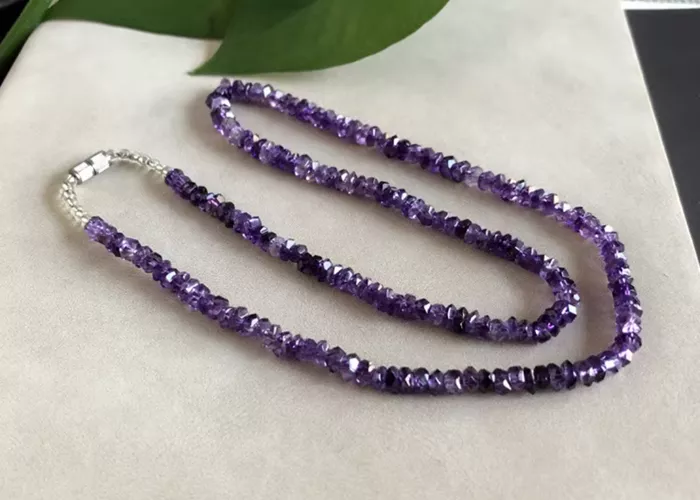Amethyst has been a favorite in jewelry design since ancient times due to its mysterious purple color and historical and cultural significance. From the mourning jewelry of the Victorian era to the geometric aesthetics of Art Deco, antique amethyst necklaces carry the craftsmanship code of The Times. However, with the rise of the retro trend, the market is flooded with a large number of antique-style products. This article will systematically analyze the key points of identification from four dimensions: material, craftsmanship, historical characteristics, and market traps.
Historical Background: The era Imprint of antique amethyst necklaces
The Victorian Era (1837-1901)
Design style: Predominantly naturalistic, with common patterns such as grapevines, flowers, and snake shapes symbolizing immortality and mourning.
Metal material: It is mostly inlaid with low-purity gold (9K-15K) or silver, and the back often retains the rough texture of hand-hammering.
Gemstone cutting: Amethysts are mostly Cut with the old-fashioned Rose Cut or Table Cut. The edges and corners are relatively rounded and the fire is relatively weak.
Edward’s Period (1901-1910)
Technological innovation: The introduction of platinum inlay technology, with the slender “Milgrain” decoration becoming a signature feature.
Gemstone pairing: Often combined with diamonds and pearls to highlight a sense of lightness.
The Art Deco period (1920-1935)
Geometric aesthetics: Symmetrical radial designs and black and white contrasts (such as amethyst with agate) are popular.
Machining marks: Parallel fine lines from early lathe processing can be seen on metal parts, which are quite different from the smooth edges of modern laser cutting.
Key clue: If a necklace claims “Victorian style” at the same time but has fine laser-engraved patterns, it is very likely to be a modern counterfeit.
Material Analysis: The “Time Code” of Metals and Gemstones
Identification of metal parts
Oxidation and Wear
Antique silver jewelry, due to long-term oxidation, will form a uniform black patina in the crevices, while modern aged silver often uses sulfides for rapid corrosion, resulting in a stiff color.
The weld joints of gold jewelry are usually thick and may leave weld marks of different colors due to multiple repairs.
Metal purity marking:British antique silver is marked with symbols such as “lion” and “crown”, while French silverware is engraved with “Minerva’s head”.
Note: European gold jewelry before 1940 was usually marked with “Karat” rather than “Carat” (such as “18KR”).
The natural characteristics of amethyst
Color distribution: The color of natural antique amethyst is uneven, and there may be color bands or pale yellow transition areas. The color of modern synthetic products is too uniform.
Inclusion
Antique amethysts often feature “tiger-striped” liquid inclusions or needle-like rutile crystals.
The inclusions of modern heat-treated amethyst often crack due to high temperatures, forming white “egg-shaped” marks.
Ultraviolet fluorescence: Natural amethyst shows weak reddish-brown fluorescence under long-wave ultraviolet light, while synthetic products may show no reaction or emit strong blue light.
Craftsmanship Details: The Truth Under the Microscope
Manual marks vs. Mechanical processing
Inlay technique
The Claw Setting base of antique works is irregular, and the claw feet vary in thickness. Most modern counterfeits are standardized “honeycomb inlays”.
Observe the back of the gemstone: The hand-carved metal base often has tool scratches, while the base of the counterfeit is too smooth.
Link structure
In the 19th century, necklaces mostly used the “Link Chain” type. Each link was hand-welded and there were tiny gaps at the joints. Most modern counterfeits are machine-pressed one-piece chains.
Flaws in imitation and aging
Deliberate wear and tear: The edges of fake wear and tear are too sharp, while genuine antique wear and tear presents a soft “pebble effect”.
Coating peeling: The peeling areas of the coating of modern gilded and silver jewelry will expose the underlying copper or nickel, while the peeling of antique Rolled Gold will reveal the metal layer.
Market Traps: Unveiling Common Counterfeiting Tactics
The “mashup and reorganization” scam
The antique amethyst is re-set on a modern metal stand, using genuine gemstones to confuse the public.
Key points for identification: Check whether the wear of the metal and the gemstone is consistent and whether there is any new solder residue at the setting.
Certificate fraud
Forged the “Victorian Appraisal Document”, but printed with modern chemical ink or using incorrect historical terms (such as marking “Art Deco” as 1900 years ago).
Misleading light source
The seller may use warm light to cover the blue tone of the synthetic amethyst. It is recommended to observe it under natural light.
Professional Appraisal Tools and Institutions
Essential tools
10x magnifying glass: Observe gemstone inclusions and metal processing marks.
Ultraviolet flashlight: For detecting fluorescence reactions (operation required in a darkroom).
Magnet: Test whether the metal is non-magnetic antique silver or gold.
Authoritative institutions
GIA (Gemological Institute of America) : Provides reports on the origin and treatment of gemstones.
NAJ (National Antiques and Jewellery Association of the United Kingdom) : It can issue a certificate of age.
Collection Suggestions: Three Major Principles for Risk Avoidance
“Better to be skeptical than to be cheap” : Antique jewelry that is 30% lower than the market price is very likely to be a trap.
“Emphasize the origin, not the story” : Require sellers to provide clear circulation records or historical archives.
“Protecting the old with the new” : Avoid contact with perfume and sweat when wearing, and wrap with acid-free cotton paper when storing.
Conclusion
Identifying antique amethyst necklaces requires a comprehensive consideration of history, science and experience. A true antique is not only jewelry but also a specimen of flowing time. After mastering these skills, you will be able to move around the antique market with more confidence and capture those purple stars that span the centuries.
Realted topics:
What Necklace Chain Lengths Complement an Emerald-Cut Amethyst Pendant Best?
What Country Has the Best Amethyst?
Can You Shower with Amethyst Necklace? Care and Tips


